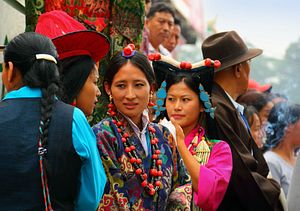Recently, an Al Jazeera article offered a profile of statelessness which featured tales of refugees from around the world. From Tibet to Kazhakstan, Syria to the Dominican Republican, the intimate glimpses of life for the millions of dislocated individuals in countries across the globe highlighted the common obstacles faced by those forced to flee their ancestral lands.
Tibet is a prime example of this 21st century phenomenon of statelessness in a world of nation-states. In fact, many parallels have been drawn between the troubled Himalayan region and stateless peoples from the Palestinians to the Kurds.
In 2015, a number of important events took place in the secretive underbelly of Tibetan exile politics – a world unto itself for those of us who have to navigate it either as members of the in group (Tibetan exiles) or out group (non-Tibetan activists, scholars, journalists), including the Tibetan exile elections, inception of the Tibetan feminist movement, the rising numbers of self-immolation protests in Tibet, and a major rebranding of the official Central Tibetan Administration (CTA) policy of “genuine autonomy” for Tibet (i.e. “The Middle Way”).
As such, I think it’s important to properly contextualize the article and clarify a few key points in regard to the issue of Tibetan refugees.
Having personally been born after the cut-off point for Indian citizenship granted to Tibetan refugees after the 2010 ruling, I, like many others, take issue with the arbitrary window period for citizenship. Although it’s certainly better than no such law at all, there is still a restriction on citizenship for future Tibetan refugees and an entire generation excluded from this opportunity. Tibetans like myself, who were naturalized in the U.S. after relocating through the special visa provision for Tibetan refugees included in the Immigration Act of 1990, are privileged in holding American citizenship. But there are far more in the settlements in India who are not so fortunate.
Beyond the issue of a cut-off point for citizenship, the very idea of Indian citizenship was hotly debated in the Tibetan exile community. Those advocating for Tibetan independence, which the exile administration opposes, have argued that granting exiles Indian citizenship when the administration is headquartered in India would negate the very existence of such an entity. An official name change of the CTA was posed in 2012 and met with vocal opposition for restricting its jurisdiction to “the Tibetan exile people,” encompassing only the exile population of roughly 128,000 rather than the entire population of Tibet (over 6 million). Indian citizenship thus has tremendous implications for any prospects for Tibetan statehood.
With the rise of disputes between Tibetan exiles in the Indian settlements and locals, legal protections for Tibetan refugees are becoming an increasing concern. Tibetan exiles are required to carry and renew a registration certificate and an identity card to travel overseas. A lack of citizenship means Tibetans are unable to own land and travel freely. Harsh penalties, including incidents of arrest, for the mere failure to renew these documents have further heightened fears over the tenuous nature of exile in the settlements. Restrictions on employment opportunities in India have also contributed to growing debate over Indian citizenship.
As we head into the new year, the plight of Tibetan refugees must be more fully addressed by the international community, lest we have yet another global humanitarian crisis on our hands.
Tenzin Pelkyi is a writer, activist, and law student. She sits on the board of the Asian American Organizing Project and is also the founder/editor of the Tibetan Feminist Collective. She writes and speaks regularly about Tibet, Asian American advocacy, reproductive rights, and racial justice.

































